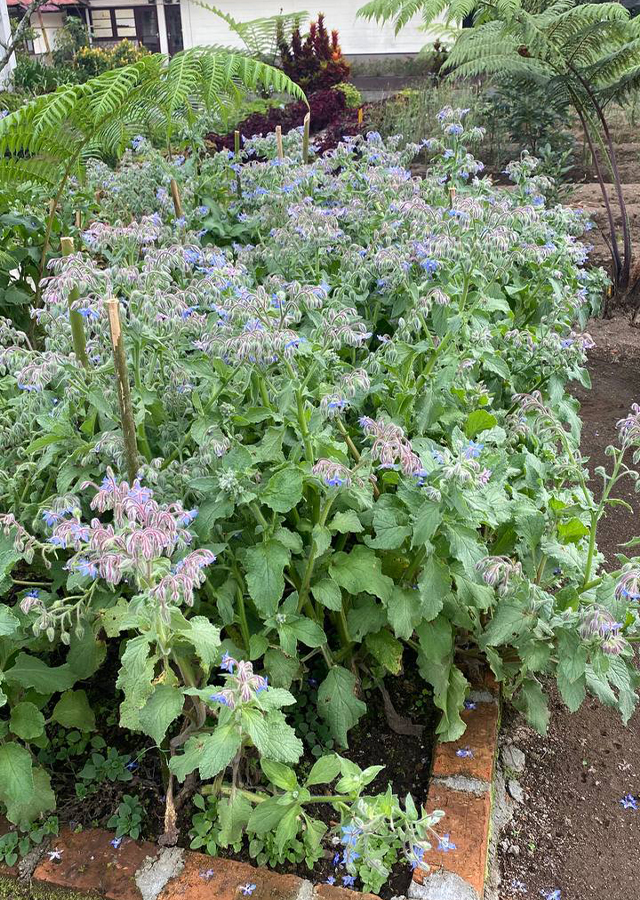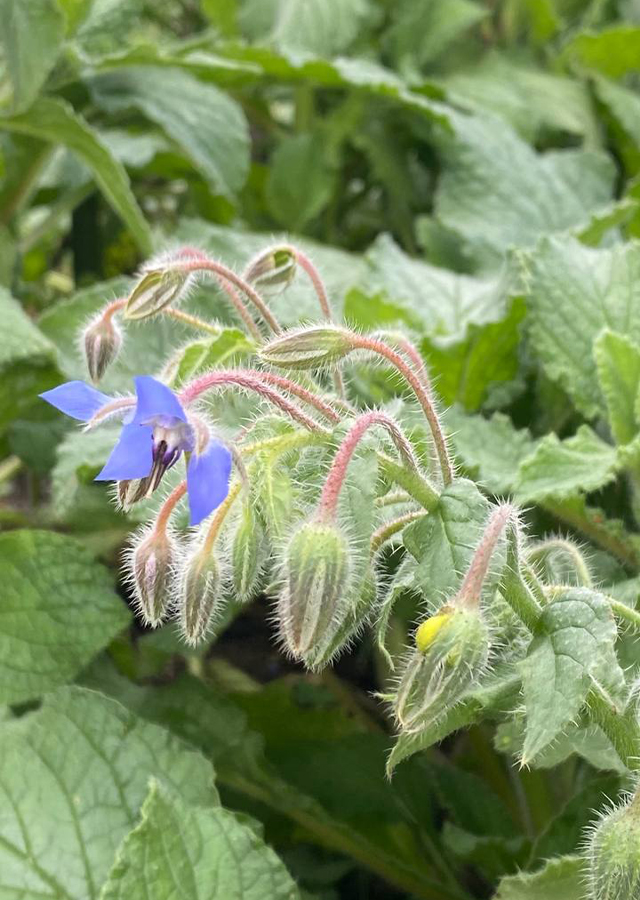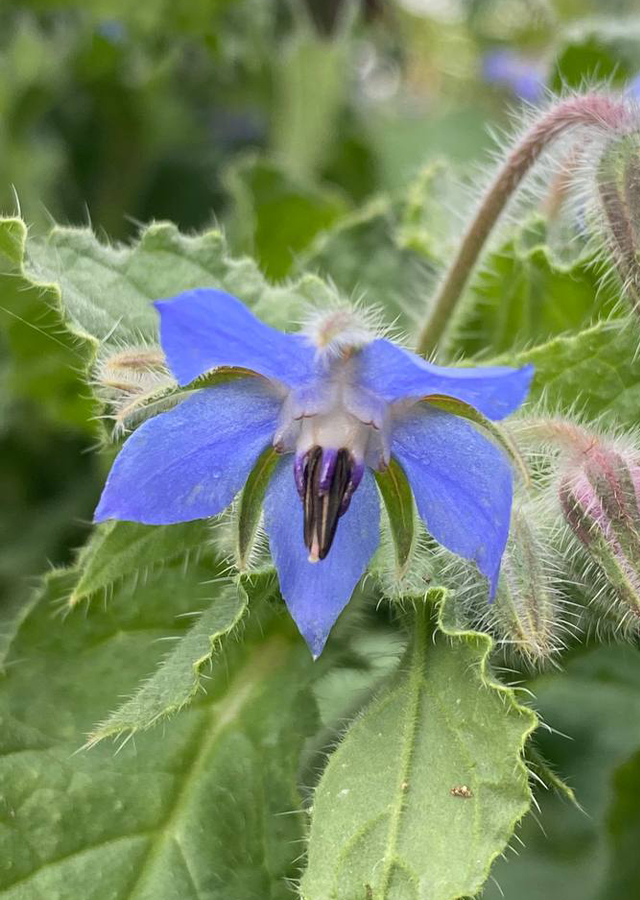Borage
Borago officinalis L.
Boraginaceae
Location in our garden
Principal



Synonym
Borago advena Gilib.
Borago aspera Gilib.
Borago hortensis L.
Habitus
Herbaceous. An erect to spreading, annual to biennial plant, often freely branched that can grow about 70-100 cm tall
Part Used
Leaves
Seeds
Flowers
Growing Requirements
Full Sunshine
Low Temperature
Habitat
Forest
Shrublands
Grassland
Terrestrial
Overview
Borago officinalis is native to the Mediterranean region. It was introduced into North America from Europe as an herbal and ornamental plant. Borage has a wide range of uses as a culinary and medicinal herb, whilst it can be harvested from the wild it is more commonly cultivated in the herb garden. The leaves can be used as a pot-herb or be added to salads, and are rich in potassium and calcium. The flowers are used as a decorative garnish on salads and summer fruit drinks. An edible blue dye can be obtained from the flowers. It is used to colour vinegar. A refreshing tea is made from the leaves and/or the flowers. The dried stems are used for flavouring beverages.
Vernacular Names
No found data on this. Need further research.
Agroecology
Can be found in waste ground near houses. Prefers a sunny position, mesic conditions, and a fertile loamy soil.It grows particularly well in loose, stony soils with some chalk and sand. Plants are tolerant of poor dry soils, though much bigger specimens are produced when the plants are growing in better conditions. Tolerates a pH in the range 4.8 to 8.3. Although an annual, the plant usually maintains itself by self-sowing, sometimes in quite a prolific manner, as long as the soil is disturbed by hoeing etc. Plants often develop mildew when growing in dry conditions or towards the end of the growing season.
Morphology
- Root - stout, tap-root system.
- Stem - light to medium green, terete, hollow, and densely covered with stiff white hairs.
- Leaves - about 5-15 cm long and about one-third as much across, ovate, obovate, or oblanceolate in shape with margins that are smooth and slightly undulate. The upper leaf surface is dark green, wrinkled from indented veins, and covered with sparse appressed hairs. The lower leaf surface is light to medium green and hairy primarily along the undersides of the veins.
- Flower - individual flowers are about 1.8-2.5 cm across, consisting of 5 lanceolate blue petals (rarely white or pink), 5 green sepals, 5 dark blue to black anthers that merge together to form a central beak, and an ovary with a single style. The linear sepals are covered with stiff white hairs along their outer surfaces, they are about the same length or a little shorter than the petals. Like the stems and sepals, the branches of each inflorescence are covered with stiff white hairs, green to dark red.
- Fruit - a small brownish oval wrinkled nutlet. Ripe nutlets are dark without albumin.
- Seed - each fruit containing 3-4 seeds, brownish.
Cultivation
Generatively propagated by seed - sow mid spring in situ. The seed can also be sown in situ in the autumn, this will produce larger plants and earlier flowering.
Chemical Constituents
Fatty acids (gamma-linolenic acid, oleic acid, palmitic acid, stearic acid, eicosanoic acid, and erucic acid), pyrrolizidine alkaloids, licosamin, intermedin, sopinin, sopindian, yezan, coline, silicic acid, malic acid, δ--bornesitol, cyanozhens, glucose, galactose, arabinose, allantoein, tannins, phosphoric acid.
Traditional Medicinal Uses
- It has beneficial affect on the mind, being used to dispel melancholy and induce euphoria. It is a soothing saline, diuretic herb that soothes damaged or irritated tissues.
- The leaves, and to a lesser extent the flowers, are demulcent, diaphoretic, depurative, mildly diuretic, emollient, expectorant, febrifuge, lenitive and mildly sedative. An infusion is taken internally in the treatment of a range of ailments including fevers, chest problems and kidney problems, though it should not be prescribed to people with liver problems.
- Externally it is used as a poultice for inflammatory swellings.
- The seeds oil helps to regulate the hormonal systems and lowers blood pressure. It is used both internally and externally, helping to relieve skin complaints and pre-menstrual tension.
Part Used
Reference Sources
- Fern, Ken. (2021). Useful Temperate Plants Database: Borago officinalis. http://temperate.theferns.info/plant/Borago+officinalis. 31-01-2022.
- Kew Royal Botanic Gardens. (2021). Plants of World Online: Borago officinalis. https://powo.science.kew.org/taxon/urn:lsid:ipni.org:names:113618-1. 31-01-2022.
- Missouri Botanical Garden. (No date). Borago officinalis. https://www.missouribotanicalgarden.org/PlantFinder/PlantFinderDetails.aspx?taxonid=242362. 31-01-2022.
- Samani, M. A., Bahmani, M., and Kopaei, M. R. (2014). The chemical composition, botanical characteristic and biological activities of Borago officinalis: a review. Asian Pacific Journal of Tropical Medicine, 7(Suppl 1): S22-S28. DOI:10.1016/S1995-7645(14)60199-1.
- Weedy Wildflowers of Illinois. (2019). Borage. https://www.illinoiswildflowers.info/weeds/plants/borage.htm. 31-01-2022.


